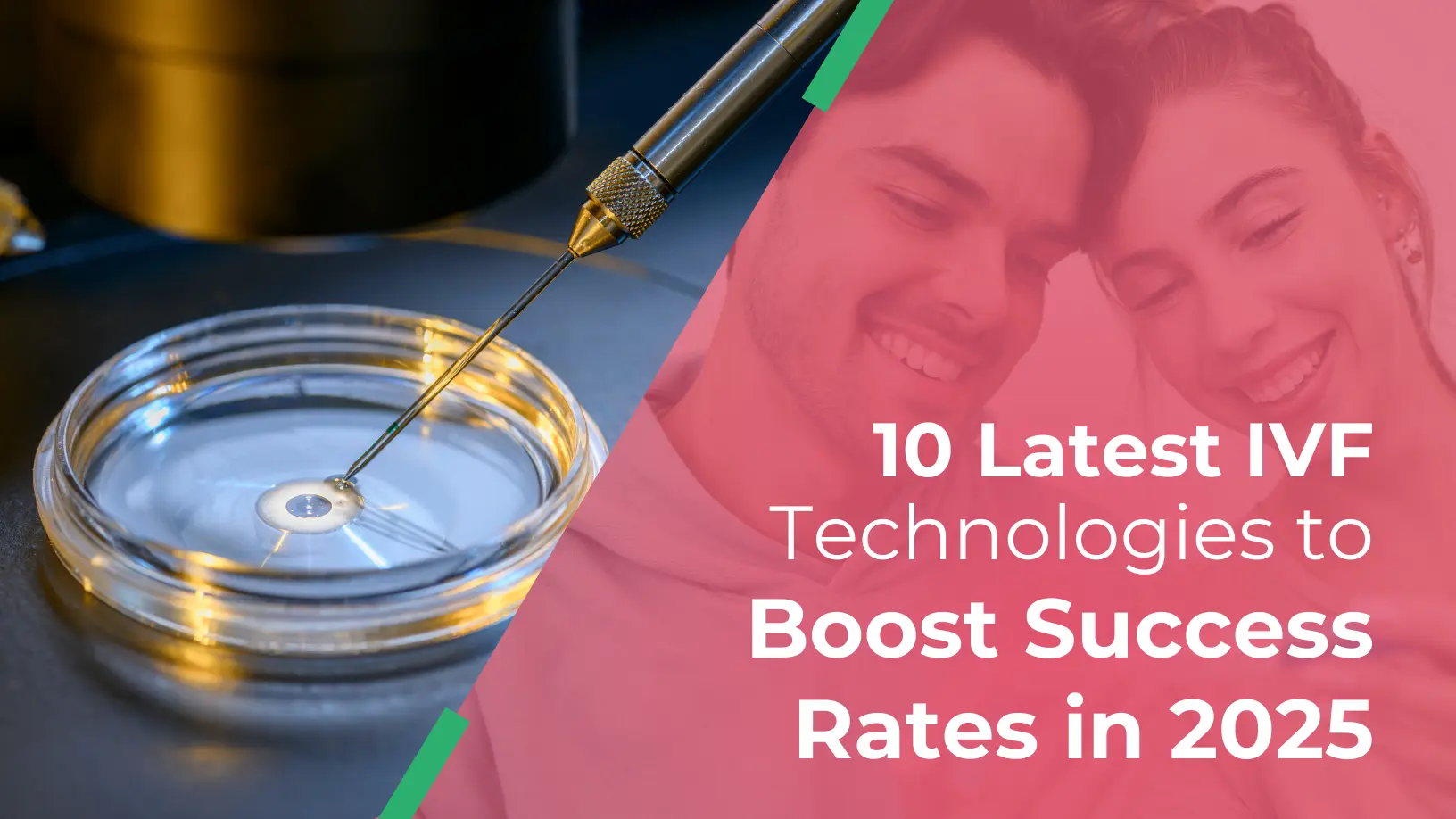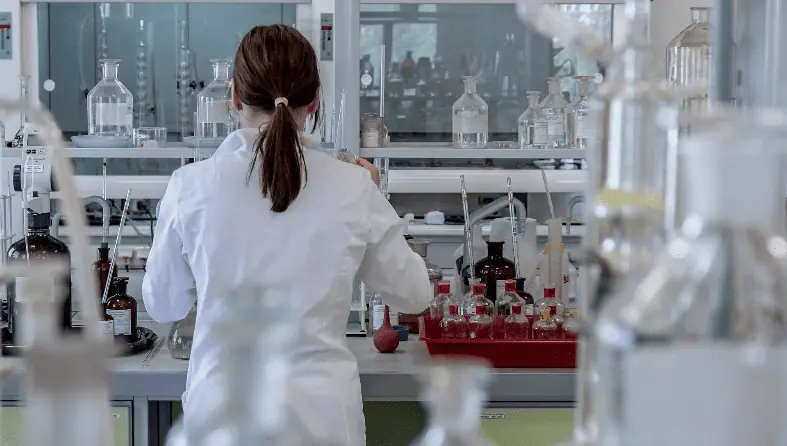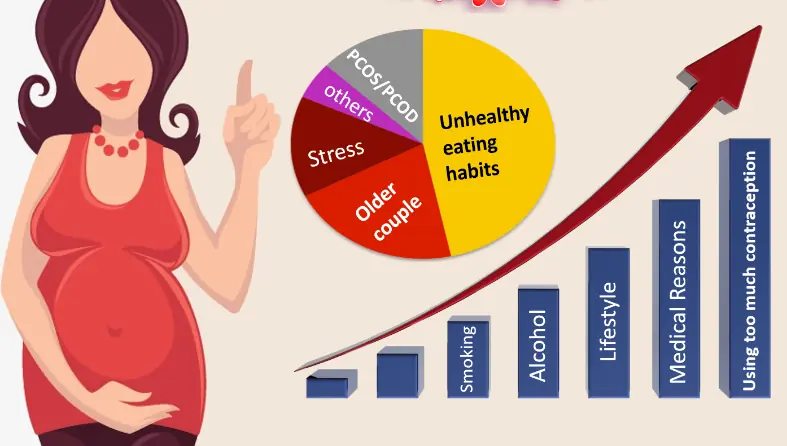10 Latest IVF Technologies to Boost Success Rates in 2025
Fertility Treatments
As we step into 2025, IVF technology has continued to advance at a remarkable pace, offering hope to millions of individuals and couples worldwide. The latest breakthroughs have made treatments more efficient, personalized, and accessible than ever before. From AI-driven embryo selection to advanced genetic screening techniques, these innovations are boosting success rates and redefining the future of fertility. This updated list highlights the top 10 cutting-edge IVF technologies of 2025, designed to improve outcomes and transform the journey to parenthood.
The major concern in the present Assisted Reproductive Technology (ART) system of India is Quality, Regulation & Transparency of fertility treatments to increase the effectiveness and health outcomes of ART treatments. Fortunately, the latest IVF technologies are addressing the above issues and are revolutionary in bringing higher success rates in IVF treatments by fulfilling parenthood dreams of many childless couples. The recent IVF protocols in the list are PRP treatment, Stem cell treatment, Embryoscope, Natural IVF cycle, Laser Hatching, I-womb technique, Vitrification – A Cryopreservation Technique, Invocell or Vagincubator and Ozone sauna therapy. But the question is, whether all these technologies are effective or are they just experimenting it on your body? To know the real truth, we interviewed best & top fertility doctors and asked their opinion on the same. This is what they have to say…
What Is The New Technology In IVF?
We at Fertility Dost, always try to bring authentic information for our readers. And so, yet again, we are here with real opinions, real information and real reviews by doctors. WE DON’T GIVE RANDOM INFORMATION. We research, ask questions to right people and then present the truth. Read further to know whether all these technologies are really effective or hyped for no reasons.
1. PRP Treatment Or Ovarian PRP Treatment
When the quality and quantity of your egg is lower than expected from your age, it’s called premature ovarian insufficiency, diminished ovarian reserve or early menopause. In this condition, before you opt for IVF process, IUI process, Egg donor or any other treatment, you can also consider Ovarian PRP as an option.
Ovarian PRP is a plasma therapy, where your own platelet-rich plasma is injected in your ovaries to rejuvenate the quantity and quality of eggs.
Click here to read more – Is PRP A Solution For Low AMH & Thin Endometrium Lining
Conclusion
While interviewing best & top fertility doctors we came to a conclusion that though PRP is a safe technique the results are still not promising as it is still in the experimental stage and is not approved for commercial purpose yet. The cost is approximate Rs. 40,000 to Rs. 1 Lakh. It is used for infertility conditions like –
- Ovarian rejuvenation
- Thin endometrium lining
- Poor ovarian reserve
- Boosting sperm production
- Vaginal tightening after having multiple births in cosmetic gynaecology for sexual satisfaction.
What Is PRP? by Dr. Rutvij Reel
“This is a latest IVF technology and still in experimental stage. Also, PRP is age specific. It is effective in younger age women and not much successful for women above age 43.”
– Dr. Nisha Bhatnagar from Aveya Fertility & IVF Centre, Delhi
2. Stem Cell Treatment
Next in the list of latest IVF technology is – Stem Cell treatment. It is a cell therapy where stem cells are extracted from mainly fat tissues or bone marrow. Your doctor will extract the healthy stem cells and inject it in your body to replace the damaged cells. These cells are called totipotent stem cells as they have the magical properties to regrow and self-place themselves to the damaged part of the body, that requires rejuvenation and rebuilding. Is this treatment safe and effective?
Must Read – Stem Cell Treatment For Infertility | A New Hope For Pregnancy
Conclusion
The doctor fraternity have not much to say and rather have mix reactions on the scientific evidence of stem cell treatment, considering the fact that it is sill in the experimental stage and is not recommended for commercial use. Very few doctors in India are practising this technique. The cost is approximately in between Rs. 20,000 to Rs. 70,000.
“This treatment is more effective than PRP treatment for ovarian reserve. Some live births are reported from stem cell treatment.”
– Dr. Keshav Malhotra from Rainbow IVF, Uttar Pradesh.
3. Natural IVF Cycle
It is called natural IVF cycle because it is more or less similar to natural reproduction as the process is carried out without stimulating the ovaries. Natural IVF cycle or mini-IVF cycle protocol is to obtain one fine egg that is naturally produced by women each month during menstrual cycle and it is believed to be of best quality.
Advantages Of Natural IVF Cycle
No risk of multiple pregnancies as there is only one embryo for implantation
- Natural IVF is a pain free procedure due to minimum usage of fertility drugs
- Cost effective as not much medications are used
- No risk of ovarian hyper stimulation syndrome (OHSS)
- Less time consuming in comparison to standard IVF treatment
Disadvantages Of Natural IVF Cycle
- No option to choose the best embryo as only one embryo is formed
- Can’t freeze embryos for next cycle as only one embryo is obtained per cycle.
- That one egg may not be of good quality to form a healthy embryo. Hence, multiple cycles might be required.
- Lower pregnancy rates
Conclusion
While one side of a doctor panel believes that it is just a matter of reducing the cost of IVF treatment by avoiding stimulation and getting fewer eggs, the other side of the doctor panel believes that it is a boon for patients who wants to try the natural way or who are allergic to heavy fertility drugs. Fertility Dost found out that, the key to success of natural IVF is highly dependent on the expertise of the doctor. So, if you are planning to go for this technique make sure that the doctor is a firm believer of this technique and got expertise in doing this treatment. Cost is approximate Rs. 50,000 – Rs. 75,000.
“I believe in natural IVF. Though egg pick up success rate is low, I prefer the natural process of the body to select the best egg. The success rate of natural IVF can be good, if it is done by an experienced doctor. Also, it is cost effective for couples.”
– Dr. Nisha Bhatnagar from Aveya Fertility & IVF Centre, Delhi
4. Embryoscope
Embryoscope, is an interesting latest IVF technology as it is a special time-lapse incubator which consists of a camera. It allows uninterrupted viewing of the embryo development without removing it out from the incubator and hence avoid exposing it to outside conditions. After every 10 mins, the embryoscope takes pictures of embryo and then a small time-lapse movie is made which then allows the embryologist to monitor the cell divisions and growth of each embryo. As a result, the best embryos are selected by the embryologist for implantation.
What Your Embryologist Should Tell You? ( Insta Reels )
Advantages Of Embryoscope
- Transparency in the growth of embryos as the time-lapse picture can be seen.
- Best embryos are selected
- Higher chances of successful embryo implantation
- Higher chances of successful pregnancy
Disadvantages of Embryoscope
- High cost of embryo culture
- Increases the cost of IVF
Conclusion
A lot of positive feedback is received on this technology. It is believed that this technology will increase the IVF success rate as it helps in prioritising and selecting the best embryo. The cost of this technique is approximately Rs- 15,000 – Rs. 30,000. But you can avoid spending extra money on this technique and still get successful IVF results if you do your research well. Yes, you heard it right. If you choose a clinic that have their own well equipped embryology lab with a full time, certified and experienced embryologist, then you can skip this technology.
Must Watch – This Is How You Choose The Best IVF Doctor
“Entire video is made on embryo developing through this embryoscope technology. It has a coding system which helps to prioritise & select best embryo. Though moderate quality evidence is available, it is a good technology.”
– Says Dr. Keshav Malhotra from Rainbow IVF, Uttar Pradesh.
5. Preimplantation Genetic Testing
PGS (Preimplantation Genetic Screening) and PGD (Preimplantation Genetic Diagnosis) both fall into the category of PGT. PGT-A (Preimplantation Genet test for Aneuploidies) is a genetic study of the embryos produced during IVF cycle. This test screens the embryos for any kind of chromosomal abnormalities before transferring them into the uterus. PGS helps in improved embryo selection by determining the chromosome number of each embryo growing into the Blastocyst stage.
To know about the cost, benefits, and time required to do this test, read our article Thinking About PGS For Next IVF cycle?
Conclusion
In our interview process with best & top fertility doctors, we found out that this technique is hyped for all good reasons. It is effective and very helpful technique. Approximate cost is Rs. 15,000 – Rs. 20,000 / embryo. Though it is not recommended to every patient, this technique is highly recommended is cases like –
- Indication of genetic abnormality
- Advanced maternity age
- History of down syndrome
- Repeat abortion
- Multiple embryo implantation failure
- Multiple miscarriages
“Definitely it is useful. And is an established technology with high success rates. Very useful for genetic testing, women at age 38+, history of down syndrome and multiple IVF failure..”
– Dr. Rutvij Dalal from Janini IVF, Delhi
6. Laser-assisted Hatching
An embryo is surrounded by a protective shell called zona pellucida. For successful implantation this outer shell breaks out naturally. But in some cases, the zona pellucida hardens making it difficult to hatch and implant which causes embryo implantation failure. The latest IVF technology called laser assisted hatching helps in successful embryo implantation by making a small crack before the embryo is inserted in the uterus in a hope that this hatching helps in implantation of the embryo leading to a successful pregnancy.
Advantages Of Laser Assisted Hatching, LAH
- In comparison to old style chemical assisted hatching and mechanical assisted hatching, LAH is more accurate
- Does not require manual handling of the embryo, hence less chances of embryo getting damaged
- Increases the chances of successful pregnancy
Disadvantages Of Laser Assisted Hatching
- Embryo may get damaged before or after the transfer
- Damaged embryo results in implantation failure. No pregnancy
- Risk of multiple pregnancy
Conclusion
Not much success rate is observed in this technique. The cost is approximate Rs. 10,000 – Rs. 15,000. And this technique is not recommended to every patient. Only patients like –
- Women in advanced age
- When opting for frozen embryo transfer
- When opting for day 3 embryo transfer
- Repeat Embryo implantation failure
“Yes, it is very effective, especially in case where the women’s age is 37+ and is opting for frozen embryo transfer.”
– Dr. Rutvij Dalal from Janini IVF, Delhi
7. I-Womb Technique
I-womb is intelligent womb technique for growing embryos in the embryology lab. The natural growth of an embryo depends on three major things inside the mother’s womb
- A particular temperature
- The level of CO2 and
- Humidity.
I-womb technique ensure that it exactly matches the above conditions and allow embryo to grow in a natural process outside the mother’s womb. Ultra-modern sensors and chips are implanted in the equipment that monitors and records data. I-womb systems are based on web, application or cloud system and represents graphical data to monitor in real-time
Advantages Of I-Womb Technique
- High-quality embryo labs
- Transparency in the growth of embryos as i-womb technique records the data real-time.
- Embryos growing in natural environment as that of a mother’s womb
- Healthy embryos are formed
- Easy to select the best embryo for implantation
- Better success rates of embryo implantation
- Better success rates of successful pregnancy
Disadvantages Of I-Womb Technique
- Only few clinics in India have this technique
- Will increase the cost of IVF
Conclusion
Though people are talking about this technology, some doctors are not aware and some are disinterested to give any opinion on this technology as there is no scientific evidence and success rate recorded as of now. Hence, Fertility Dost will also not recommend our reader to go for this treatment. Let’s wait and see what this technology has to offer in coming future, whether it will be a promising technique or yet another fancy treatment.
8. Vitrification – A Cryopreservation Technique
Vitrification is rapid freezing of eggs, sperms or embryos by adding cryoprotective agents such as salts, sugars, glycerol, FBS, glycols. This cryopreservation process minimizes the DNA damages that is caused due to ice crystal formation.
Earlier, when egg/embryos were frozen, the process was slow which caused formation of ice-crystals in freezing embryos and hence, damaging the DNA. To avoid this, the latest IVF technology – Vitrification process with new cryoprotectant that protects the DNA was invented. Dry Ice and liquid nitrogen are generally used in this method.
Benefits Of Vitrification – A Cryopreservation Technique
- Rare chances of cells getting damaged or dead
- Safety from genetic contamination
- Protects the samples from disease and microbial contamination
- Biological samples can be preserved for a longer period of time
- More embryos can be created and preserved
- Frozen embryos can be used in next IVF cycle, without spending again
- Cost effective
Disadvantages Of Vitrification – A Cryopreservation Technique
- In comparison to the standard IVF process of slow cooling technique, the vitrification technique is more useful technique for the preservation.
- Vitrification is a simple procedure that requires less time, safer and more cost effective than slow cooling.
- Hence, no such disadvantages are observed as such.
Conclusion
It used to be in experimental stage earlier, but evidence shows 90% survival rate. It is an excellent technology to preserve fertility. This technology is considered as a boon to women empowerment who don’t want to take decision based on their biological clock. Only a skilled embryologist can do this process effectively. The cost is approximate Rs. 1 Lakhs – Rs. 2 Lakhs. If you are married, then it is recommended to freeze embryos. The cost varies for freezing eggs and embryos.
“It is very good and cost effective. You can preserve your fertility for long-term as the eggs/embryo remain young irrespective of a women’s/couple’s growing age. Women or couples who want to delay marriage, pregnancy can use this technology. It is also beneficial for chemotherapy patients”
– Dr. Nisha Bhatnagar from Aveya Fertility & IVF Centre, Delhi
9. Invocell or Vagincubator
This latest IVF technology is an intervaginal culture device (IVC). It uses the natural environment of vagina for the initial embryo development. Instead of fertilising the egg & sperm outside the body in embryo lab, the IVC device fertilises egg & sperm inside the body for about 5 days. After 5 days the thumb size plastic device – IVC is removed from the vagina and the embryo formed within the IVC are then implanted in the uterus.
Advantages Of Invocell
- Cost effective
- Reduces the maintenance time of the embryo in embryology lab
- Personal involvement in the embryo formation
Disadvantages Of Invocell
- The plastic device may cause discomfort to some
- Embryo development can’t be monitored as it is inside the vagina
Conclusion
Again, this is an experimental technology. Not much evidence is received on it and hence doctors don’t recommend this. Fertility Dost will also advice you to refrain from some fancy treatments and save your hard-earned money.
10. Ozone Sauna Therapy
Ozone is made up of three oxygen atoms O3. Ozone sauna technique helps the body to efficiently take in the oxygen and utilize the benefits. The ozone sauna machine is huge & comfortable where an individual sits naked. The head is outside the machine through a hole in the top. A tube is inserted in the vagina which directly releases ozone into the reproductive system. The released ozone helps in stimulating hormonal balance, removing free radicals and contaminants that might be interfering with the conception.
Advantages Of Ozone Sauna Therapy
- Breaks Down Disease Causing Microorganisms
- Improves Blood Circulation
- Revitalizes Your Body Through Oxygenation
Disadvantages Of Ozone Sauna Therapy
- It can cause rashes that can be itchy
- Accidental inhalation of ozone gas when stepping out of the sauna. Wearing a mask can avoid this
- Should be avoided by pregnant women, people having high BP, high risk of stroke, people with transplanted organs, and one who suffers from hyperthyroidism.
Conclusion
No evidence on whether it helps in improving the fertility health. However, few doctors are practising it for general health improvements. Fertility Dost will not recommend this for your fertility treatment. However, do your research well if you need it for other health reasons.
“It is more like energy-based devices. The effect is not permanent and repeat session is required. Approximate cost – Rs. 30,000 / session or more.”
– Dr. Neha Tiwari from Shandilya Multispecialty Clinic, Varanasi
All these latest IVF technologies are practised in ONLY high-quality fertility clinics. These clinics are following strict IVF protocols to give you best fertility treatments with high successful pregnancy rates. Ask your doctor about these treatments and whether it can help you in your treatment. The cost & efficiency depends upon the clinic and skills of the doctor, technicians and specialists. However, if you are not able to find such well-equipped fertility clinics then contact us for IVF Doctor Matching service and we will help you in choosing the right IVF Doctor based on your fertility condition in your own city.
Book Your Free Consultation Now!
About The Author








Your Comment Is Valuable For Us
Thanks For Your Feedback.